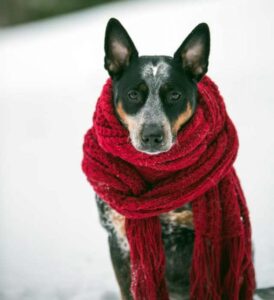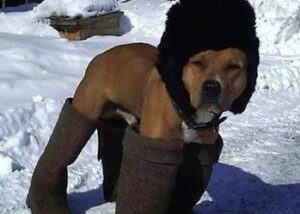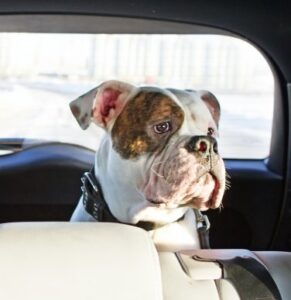Four Seasons of Furry Comfort: Winning over Winter’s Challenges

Pacific Northwest winters are mild compared to a lot of other climates, where we only get one or two large snowfalls or systems of freezing temperatures, but that doesn’t mean we can fully relax and assume our furry friends have nothing to worry about. We’re dedicated to taking great care of your pets in the cold weather, and that extends beyond our appointments. Here are 7 tips you can use to keep them safe when they’re in your care.
A winter checkup with your veterinarian is never a bad idea! Having a better picture of your pet’s health and limitations in cold weather is a great place to start. Like us, our pets burn extra energy staying warm in the winter time, even if they’re walking the same routes. Check with your vet to see if you can reward your furry friends with a little bit more food to offset the extra calories they’re burning. Hydration is also just as important in the cold months as it is in the warm month, which also helps prevent dry skin. Along with having a service like Frolic providing regular walks, here is a link with some additional ideas for exercising your dog in Winter!
 If you’ve got a short-haired dog, especially a smaller breed, a coat that provides coverage of the belly is recommended to keep them warm. Less obvious may be that long-haired dogs actually do need to continue getting occasional trims to make sure they’re not getting ice balls, salt/de-icing chemicals, or other irritants matted in their hair which may cause ice balls or skin irritation, especially the hairs between the foot pads. Also, keep a good supply of protectants for their toes on hand. Cold weather, ice, snow and salt on sidewalks can cause cracking and damage to their feet, so products like Musher’s Secret or PawTection will help protect, moisturize and provide traction too.
If you’ve got a short-haired dog, especially a smaller breed, a coat that provides coverage of the belly is recommended to keep them warm. Less obvious may be that long-haired dogs actually do need to continue getting occasional trims to make sure they’re not getting ice balls, salt/de-icing chemicals, or other irritants matted in their hair which may cause ice balls or skin irritation, especially the hairs between the foot pads. Also, keep a good supply of protectants for their toes on hand. Cold weather, ice, snow and salt on sidewalks can cause cracking and damage to their feet, so products like Musher’s Secret or PawTection will help protect, moisturize and provide traction too.
 Just like with us, frostbite happens when the body gets too cold, and pulls warmth from limbs and edges of the body into the center to stay warm. Here’s some more detailed information about Frostbite and what to look for.
Just like with us, frostbite happens when the body gets too cold, and pulls warmth from limbs and edges of the body into the center to stay warm. Here’s some more detailed information about Frostbite and what to look for.
More common, and much more dangerous, is hypothermia. Hypothermia is caused by low body temperature, and happens faster to animals in poor health or with reduced circulation. Here’s a useful guide about Hypothermia and what to look out for. Your vet will assess what kind of damage has been done, and take the necessary steps to treat them.
 If you’ve got a furry feline friend, do your best to make sure that they don’t have access to wherever you keep your car! Cats will curl up just about anywhere that’s warm and cozy, including recently-turned off car engines. Check beneath the car, honk the horn, or knock on the hood to scare them out of their warm and dangerous hiding place.
If you’ve got a furry feline friend, do your best to make sure that they don’t have access to wherever you keep your car! Cats will curl up just about anywhere that’s warm and cozy, including recently-turned off car engines. Check beneath the car, honk the horn, or knock on the hood to scare them out of their warm and dangerous hiding place.
Having your furnace checked, or using a carbon monoxide monitor in the house is also a good idea. Since carbon monoxide is odorless, we may not notice it, especially if we spend less time at home than our pets do, making them more vulnerable to carbon monoxide poisoning than us. Carbon monoxide can cause headaches, trouble breathing, and fatigue.
 If it’s too cold for you, it’s probably too cold for your pet. Never leave your pets outside in cold weather, where they can freeze, get disoriented, or worse. Cars are also a death trap in the winter—while they retain heat in the summer, they act as a refrigerator, holding in the cold in the winter.
If it’s too cold for you, it’s probably too cold for your pet. Never leave your pets outside in cold weather, where they can freeze, get disoriented, or worse. Cars are also a death trap in the winter—while they retain heat in the summer, they act as a refrigerator, holding in the cold in the winter.
Washington State law RCW 16.52.340, states that is a “class 2 civil infraction to leave or confine any animal unattended in a motor vehicle or enclosed space if the animal could be harmed or killed by exposure to excessive heat, cold, lack of ventilation, or lack of necessary water,” according to the Washington State Legislature website.
Our pets’ tolerance for cold isn’t as great as ours, so be sure to closely monitor their behavior in cold weather!